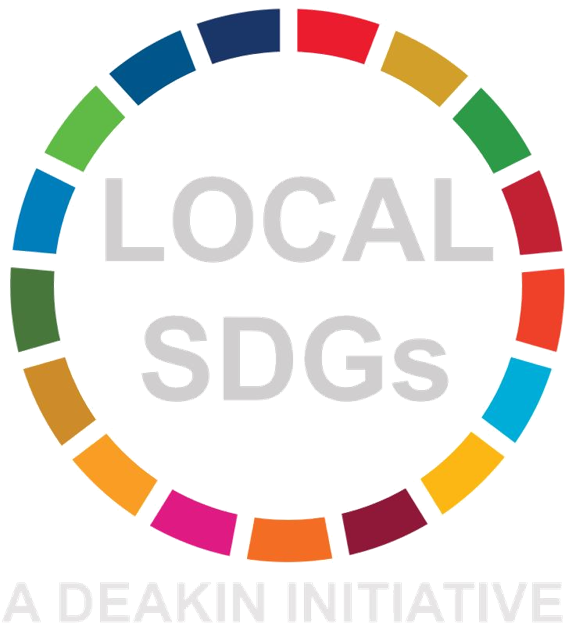Approaching Goulburn-Murray
The Goulburn Murray region is a strategic area for Victoria and has long been subjected to planning and strategic discussion through intensive engagement with decision-makers and practitioners. This planning history has led to a high-level systems thinking ability, already shaped a shared perspective about the future of the region among stakeholders, and has created a rich source of data and models. However, the risk of stakeholder fatigue due to over-engagement in other participatory processes in Goulburn Murray has become likely. This risk led us to rely more on the use of existing data and documents and to use the stakeholder capacity more carefully, for consultancy and validating the results of the contextual analysis process and for informing the development of the system dynamics model of Goulburn Murray.
Priority Sustainable Development Goals for GM
As a result of this, we have started to identify the local priority SDGs in Goulburn Murray through a systematic contextual analysis of scientific and policy documents, reports, and interviews conducted during previous projects with the Goulburn Murray Irrigation District (GMID). The top five SDGs across all documents were SDG6 Water, SDG2 Zero Hunger (Agriculture), SDG15 Life on land, SDG8 Decent work and Economic Growth, and SDG13 Climate Action (fig. 1). This is the impetus for an in-progress paper and consultation with stakeholders in Goulburn Murray through a workshop to present the results of the first phase of the project for feedback and validation with local experts.
Figure 1: Priority SDGs in Goulburn-Murray identified from the contextual analysis by expert judgment.
Assessing Challenges
The process of identifying the risks and opportunities is completely connected to the output of defining local sustainability dimensions and mapping the interactions between the priority SDGs and targets in this area. The key objectives of systematic assessment of literature related to the Goulburn Murray area are:
to downscale and identify priority SDGs
to map the interactions between the targets of priority SDGs
to analyse the nature of interactions among the priority SDGs in this area.
The challenges identified across the SDGs can reinforce each other and create even more complex issues in the region. To obtain an integrated perspective, we mapped how the identified SDGs can interact and create positive synergies and negative trade-offs in Goulburn Murray. As an example:
Agricultural activities (SDG 2) have negative effects on water resources, impacting water pollution and water availability in this region (SDG 6).
Pollution results from unsustainable agriculture with efforts required to restore the environment and related ecosystems (SDG 15).
Agriculture is also the main cause for land use change and land degradation in the region (SDG 15) through the expansion of croplands and fertiliser application damaging the soil health.
Balancing Risks with Opportunities
A careful balance is necessary between increasing the agriculture and protecting and restoring lands and ecosystems to control this negative, reinforcing loop of interactions. The same SDGs can also create synergetic effects, enhancing local sustainability in the region. For example, tourism (SDG 8) can bring significant income to the region and could be the opportunity for income with less reliance on agricultural activities through the unsustainable expansion of agricultural land (SDG 2). Limiting the land use change (SDG 15) can have a major effect on protecting the native vegetation, subsequently enhancing the wellbeing of terrestrial ecosystems and reinforcing the protection of local biodiversity in Goulburn Murray and the surrounding environment (SDG 15 and SDG 6). By reducing unsustainable agricultural activities, water quality can be improved, water related ecosystems can be protected (SDG 6), and land degradation and declining soil quality can be halted too (SDG 15).
The Path Ahead
The qualitative results which we have done so far will provide the basis for system dynamics modelling and inform the delineation of system boundaries in the Goulburn Murray area. These outcomes will determine the main sub-systems, components, causal and functional relationships of a system dynamics model and should also enable us to simulate and reproduce synergies between the SDGs. Figure 2 shows five sub-systems in our system dynamics model which include water, agriculture and food, economy, climate, and environment. We intend to write one or two academic papers based upon developing this system dynamics model to quantitatively analyse the complex system in our case study and provide useful tools for policymakers and local authorities to support decision making to achieve the 2030 Agenda for sustainable development.
Figure 2: Overview of the system dynamics modelling in Goulburn Murray. It contains five sub-systems according to the SDGs. The arrows show either both positive (synergy) or negative (trade-off) interlinkages between the sub-systems of Goulburn Murray

